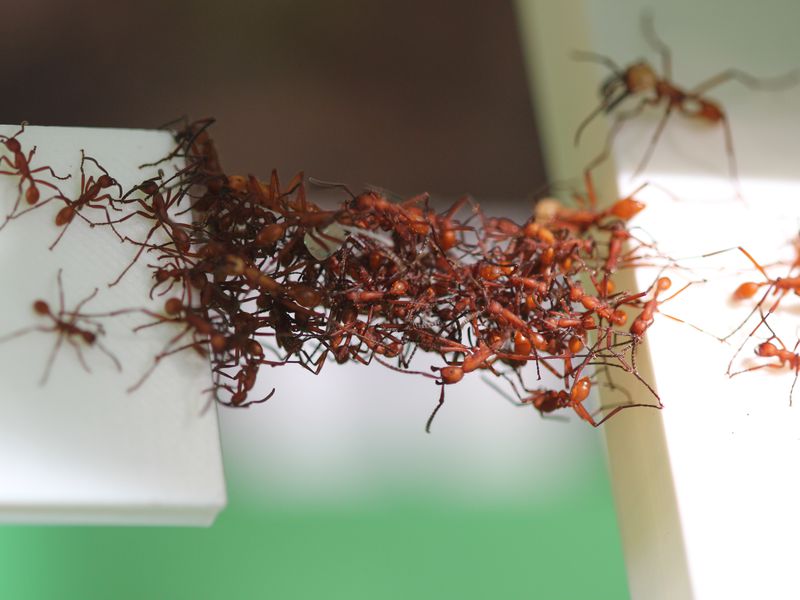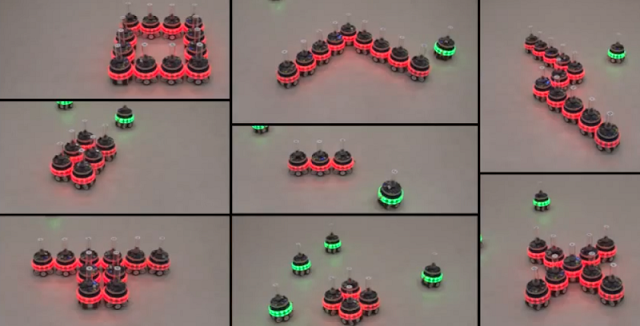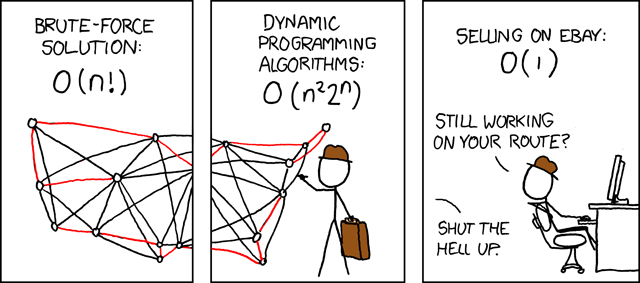Intelligence en Essaim
Jacopo De Stefani
05/03/2018
Pourquoi je vous parle de ça?

Etudiant (2012-2013): INFO-H-414 - Swarm Intelligence
Mémoire (2013-2015): Spatial Allocation in Swarm Robotics
Actuellement: Doctorant en Machine Learning
Qu’est-ce que c’est?
Swarm Intelligence
“Swarm intelligence is the discipline that deals with natural and artificial systems composed of many individuals that coordinate using decentralized control and self-organization.”
Marco Dorigo and Mauro Birattari (2007) Swarm intelligence. Scholarpedia, 2(9):1462.
Self-organization
“Self-organization is a process in which pattern at the global level of a system emerges solely from numerous interactions among the lower-level components of the system. Moreover, the rules specifying interactions among the system’s components are executed using only local information, without reference to the global pattern”
Gerardo Beni. From swarm intelligence to swarm robotics. In Swarm Robotics, pages 1-9. Springer, 2005.
Taxonomie - Sur base de la nature des agents:

Naturel

Artificiel
Taxonomie - Sur base de l’objectif:
\[ y_i = f(?,?,?) \]
Scientifique : Comprehension du système
\[ f(x_1,\cdots,x_n) \rightarrow y_1,\cdots,y_n \]
Ingégnerie : Exploitation du système
Examples - Naturels
Flocking

Schooling

Synchronisation des metronomes
Synchronisation des lucioles
Comment ça marche?
while(True):
counter +=1
# Signaling part
if counter > T:
signal
counter = 0
# Synchronization
if signal_detected:
counter += alpha * counter
Examples - Artificiels
Robotique en essaim
“Swarm robotics is the study of how to design groups of robots that operate without relying on any external infrastructure or on any form of centralized control. In a robot swarm, the collective behavior of the robots results from local interactions between the robots and between the robots and the environment in which they act”
Marco Dorigo et al. (2014) Swarm robotics. Scholarpedia, 9(1):1463.
M. Brambilla, E. Ferrante, M. Birattari, and M. Dorigo. Swarm robotics: a review from the swarm engineering perspective. Swarm Intelligence, 7(1):1-41, 2013.
Propriètes desirées:
- Tolerance au défauts
- Scalabilité
- Flexibilité
Transport collectif
Auto-assemblage
Essaim héterogène
ACO
Ant colony optimization (ACO) is a population-based metaheuristic that can be used to find approximate solutions to NP-hard optimization problems.
Marco Dorigo (2007) Ant colony optimization. Scholarpedia, 2(3):1461.
Pseudo-code
1. Initialization fourmis 2. Selection route 3. Mise à jour phéromone
Equations
ACO - Pseudo-code
1. Initialization fourmis 2. Selection route 3. Mise à jour phéromone
Selection route
\[ p_{xy}^k = \frac { (\tau_{xy}^{\alpha}) (\eta_{xy}^{\beta}) } { \sum_{z\in \mathrm{allowed}_y} (\tau_{xz}^{\alpha}) (\eta_{xz}^{\beta}) } \]
Mise à jour pheromone
\[ \tau_{xy} \leftarrow (1-\rho)\tau_{xy} + \sum_{k}\Delta \tau^{k}_{xy} \]
où:
\(\eta_{xy}\) represente la valeur héuristique associé au problème
\(\tau_{xy}\) represente la valeur du pheromone
Application - Problème du commis voyageur (TSP)

Solution possible:
Permutation des villes: \[ [v_1, \cdots, v_n] \]
Formulation:
\[\eta_{xy} \rightarrow \frac{1}{d_{xy}}\]
Et maintenant à vous d’essayer!
Ici
http://www.wooclap.com/LDHHPB
Mais aussi chez vous!
ARGOS - Simulateur
Simulations
Des questions?

Comment ça marche?
Reynolds, Craig W. “Flocks, herds and schools: A distributed behavioral model.” ACM SIGGRAPH computer graphics. Vol. 21. No. 4. ACM, 1987. http://www.red3d.com/cwr/boids/